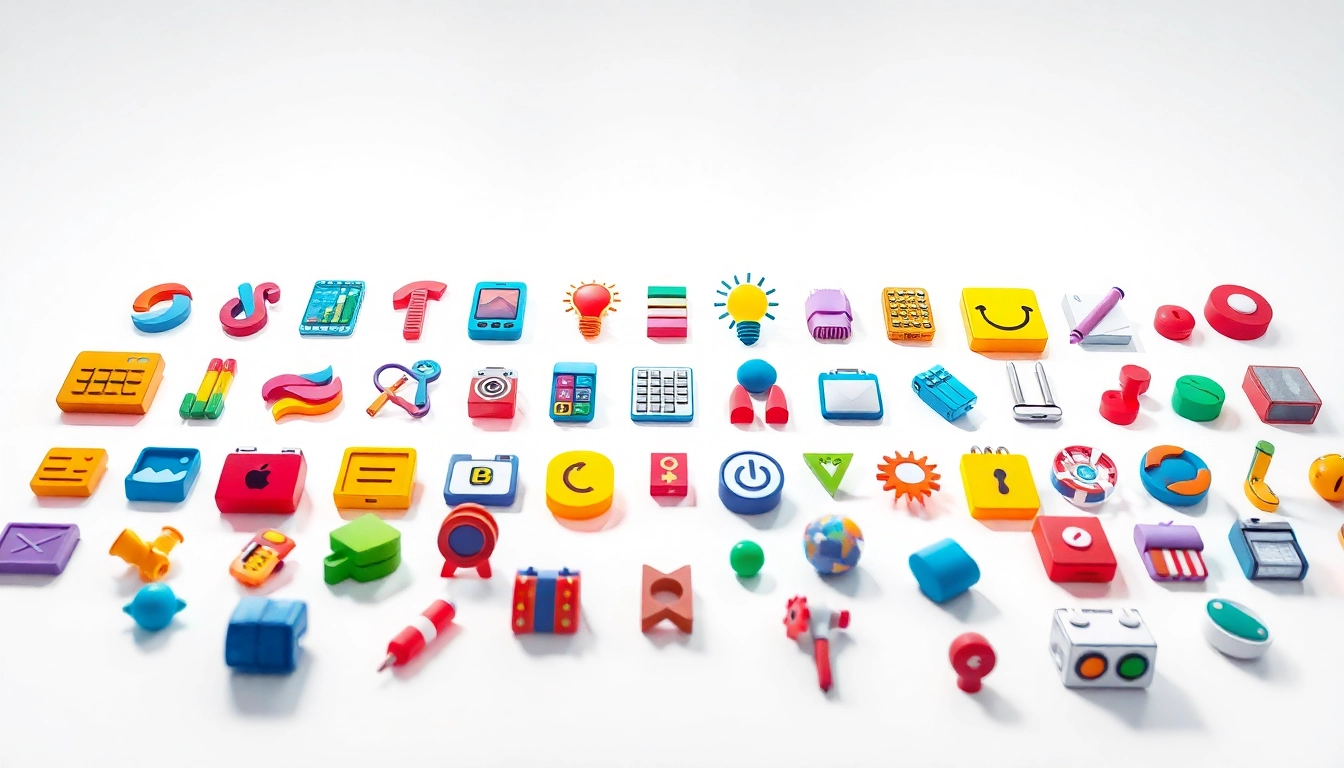Understanding Icons: Definition and Importance
What are Icons?
Icons are graphical representations that symbolize real-world objects, actions, or concepts. Typically small and intuitive, they help facilitate communication through visual cues. An effective icon distills complex ideas into simple visuals that users can easily interpret, making them an essential element in various fields such as design, user interface (UI), and web development. Icons play a significant role in enhancing user experience, as they enable quick recognition and understanding without the need for verbose explanations.
The Role of Icons in Design
In the realm of design, icons function as visual shortcuts, aiding users in navigation and usability. Their primary role is to simplify the interplay between the user and the interface, reducing cognitive load and fostering engagement. Icons allow designers to convey information succinctly. For instance, a trash can icon universally signifies deletion across many platforms, making it easier for users to identify functions quickly.
Furthermore, the importance of Icons is reflected in their ability to attract attention and convey brand identity. Unique icon designs can embed themselves in a user’s memory, associating the visual with a specific product or service, thereby strengthening brand recognition.
Common Uses and Applications of Icons
Icons are used widely across digital landscapes, including websites, mobile applications, software interfaces, signage, and marketing materials. They enhance user interaction by guiding behavior and providing contextual information. Here are some common applications:
- Navigation: Icons simplify user navigation by replacing text labels with recognizable symbols, allowing for a cleaner design.
- Indication: They indicate statuses such as connectivity, battery levels, and notifications, providing users with vital information at a glance.
- Branding: Logos often incorporate icons to represent a company’s values or mission visually.
- Infographics: In this format, icons can help present data visually, making complex information digestible.
- Accessibility: Icons assist users, especially those with reading difficulties, by providing visual cues instead of relying solely on text.
Types of Icons and Their Characteristics
Visual Icons: A Closer Look
Visual icons are static, non-interactive symbols. These are primarily used to represent concepts or functions clearly. Common visual icons include the magnifying glass for search functionality and the envelope for email. The design of visual icons should focus on clarity, ensuring that the message is conveyed immediately to the viewer.
Interactive Icons: Enhanced User Experience
Unlike static icons, interactive icons respond to user actions, such as clicks or hovers. They often change appearance to indicate their state (for instance, a filled icon may denote an active selection). Such icons enhance user engagement by fostering direct interaction, making complete use of visual feedback to confirm actions or navigation.
Cultural Icons: Significance in Communication
Cultural icons reflect symbolic meanings within specific communities or societies. Their design and effectiveness can vary based on cultural context. Certain symbols, like a heart icon for love or an international symbol for peace, transcend language barriers and communicate universally understood ideas. It’s crucial for designers to consider cultural sensitivities when creating icons, as misinterpretation can lead to confusion or even offense.
Designing Effective Icons
Key Principles of Icon Design
Designing effective icons requires adherence to several principles:
- Simplicity: Icons should be simple and clear, avoiding unnecessary detail.
- Consistency: The design style should be harmonious throughout the interface to maintain user familiarity.
- Scalability: Icons must remain recognizable at various sizes, as they can be displayed on different devices and screens.
- Meaningfulness: Each icon should communicate its intended message clearly, ensuring users understand its meaning without confusion.
- Feedback: Icons should provide feedback during interactions, helping users recognize their actions.
Color Theory and its Impact on Icons
Color theory significantly impacts how icons are perceived and understood. Various colors evoke different emotional responses and communicate unique messages. For instance, red often denotes urgency or warning, while blue can imply trustworthiness and calm. Designers should consider these associations when selecting colors for icons to ensure that the intended message aligns with users’ interpretations.
Best Practices for Icon Design Projects
A successful icon design project should follow best practices to maximize effectiveness:
- Research: Analyze existing icons within the intended context and identify gaps for innovation.
- Sketch: Begin with sketches to outline various concepts and refine the best ideas before moving to digital formats.
- Iterate: Seek feedback from users during the design process and be prepared to iterate on designs based on real-world user experiences.
- Test: Conduct usability testing to verify icons facilitate user interaction as intended.
Tools and Resources for Creating Icons
Popular Software for Icon Design
Several tools and software are available to assist designers in creating high-quality icons:
- Adobe Illustrator: A versatile graphic design tool that allows for precise vector icon creation.
- Sketch: A favorite among UI/UX designers for its ease of use and focus on web and mobile interface design.
- Affinity Designer: A cost-effective alternative to Adobe products, known for its sophisticated vector tools.
Online Platforms for Icon Creation
For those who prefer web-based solutions, there are numerous platforms offering icon creation services:
- Canva: Known for its user-friendly interface, Canva allows for drag-and-drop icon design with various templates.
- Figma: A collaborative platform ideal for multi-designer projects, focusing on UI elements including icons.
- Iconscout: This platform provides a library of pre-designed icons and also offers a custom icon design service.
Resources for Inspiration and Learning
Inspiration is vital for any design project. Several resources can help spark creativity:
- Dribbble: A community of designers showcasing their works, ideal for discovering new styles and trends.
- Behance: Similar to Dribbble, but broader in scope, featuring diverse creative projects including icons.
- Online courses: Platforms like Skillshare and Coursera offer courses specifically on icon design and visual communication.
Future Trends in Iconography
Emerging Styles in Digital Icons
The landscape of icon design is ever-evolving. Currently, certain trends are gaining momentum:
- Neumorphism: A design style that combines flat design with subtle 3D effects, giving icons a soft, embossed look.
- Minimalism: A continuation of simpler designs with less complexity, focusing on essential shapes and colors.
- Animated Icons: Increasingly prevalent due to their ability to provide interaction hints and enhance storytelling.
Impact of Technology on Icon Design
Advancements in technology are significantly influencing how icons are designed and used. The rise of augmented reality (AR) and virtual reality (VR) is prompting designers to explore new three-dimensional icon formats that can be interacted with in immersive environments. As technology progresses, designers must adapt by embracing these advancements to create dynamic and engaging icon experiences.
Predictions for the Icon Design Industry
Looking ahead, the icon design industry is expected to grow, driven by the increasing demand for user-friendly interfaces across various digital platforms. Designers will likely focus on creating inclusive icons that cater to diverse audiences, particularly considering accessibility needs. The integration of machine learning and artificial intelligence may also shape future trends, automating aspects of design to enhance creativity and efficiency.



